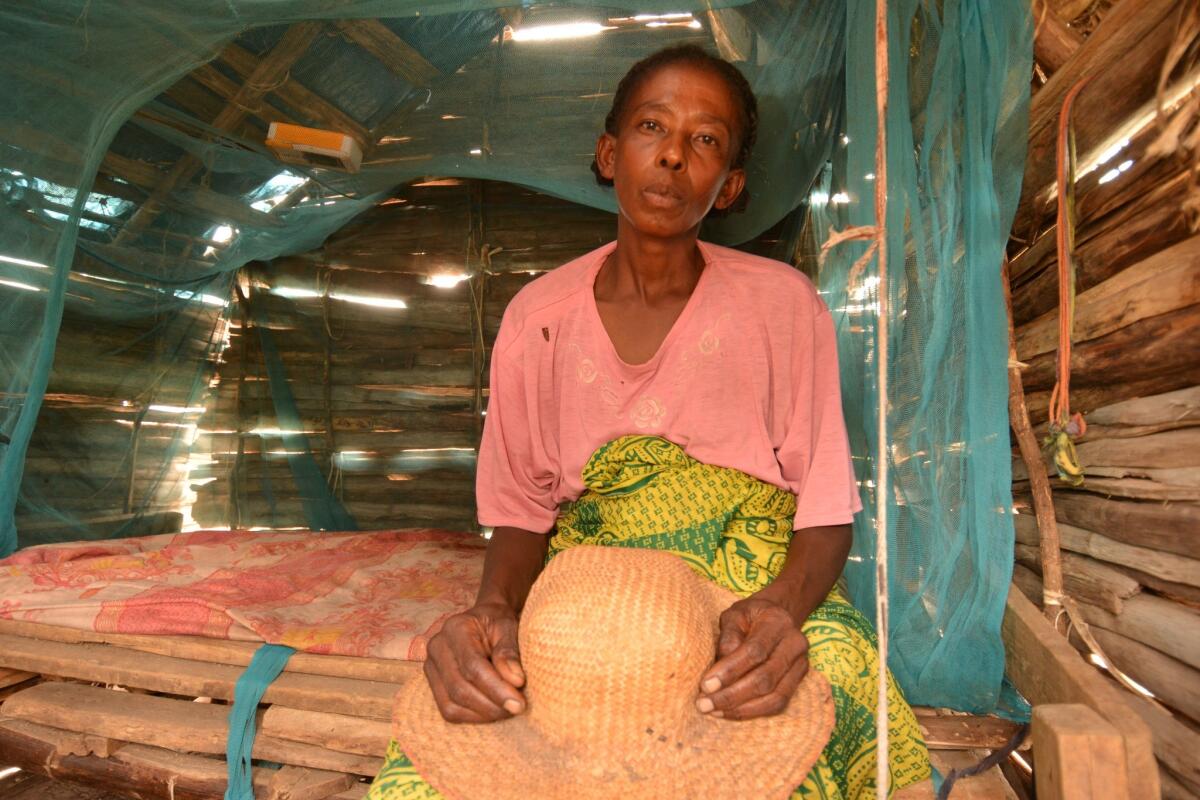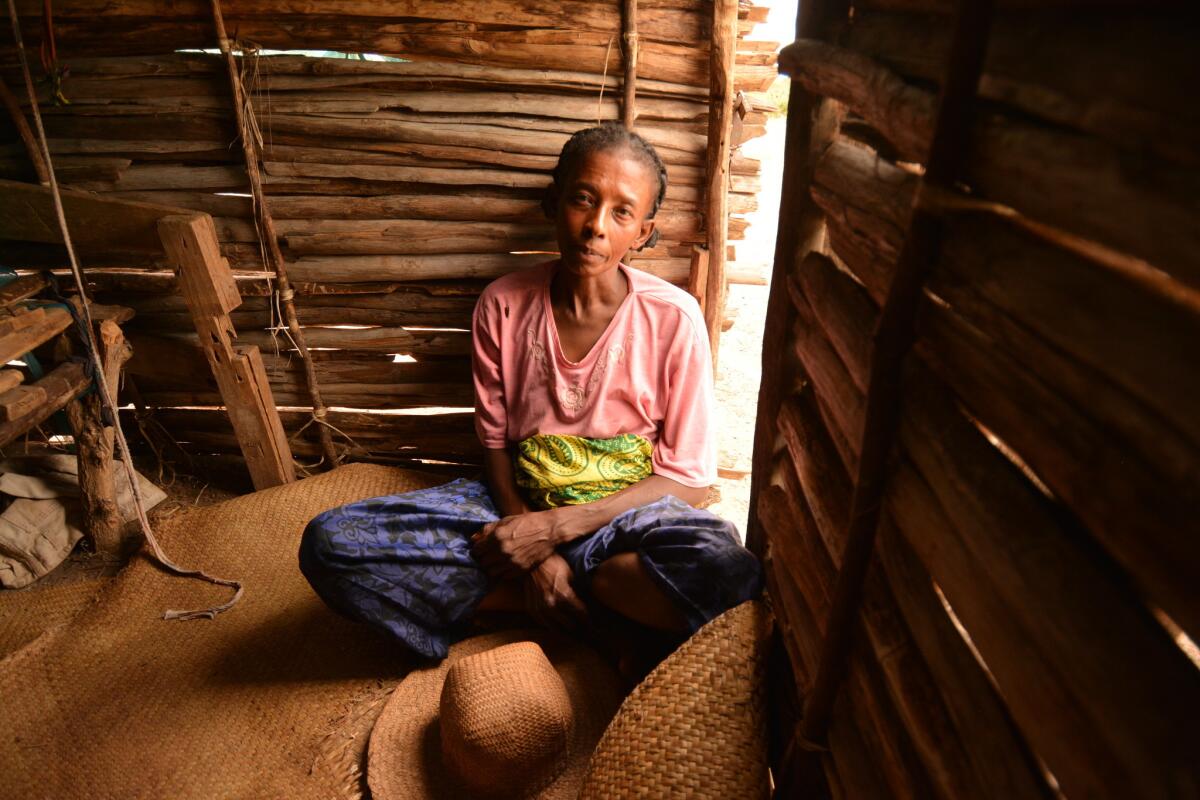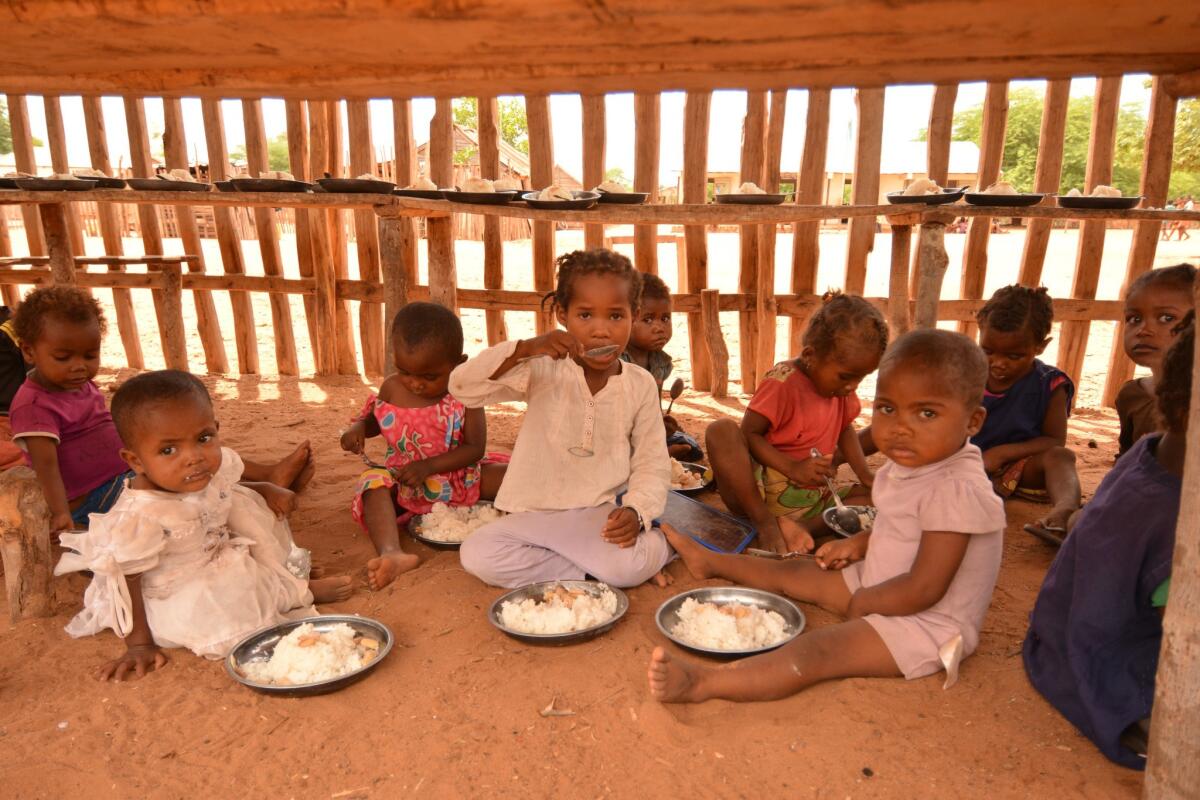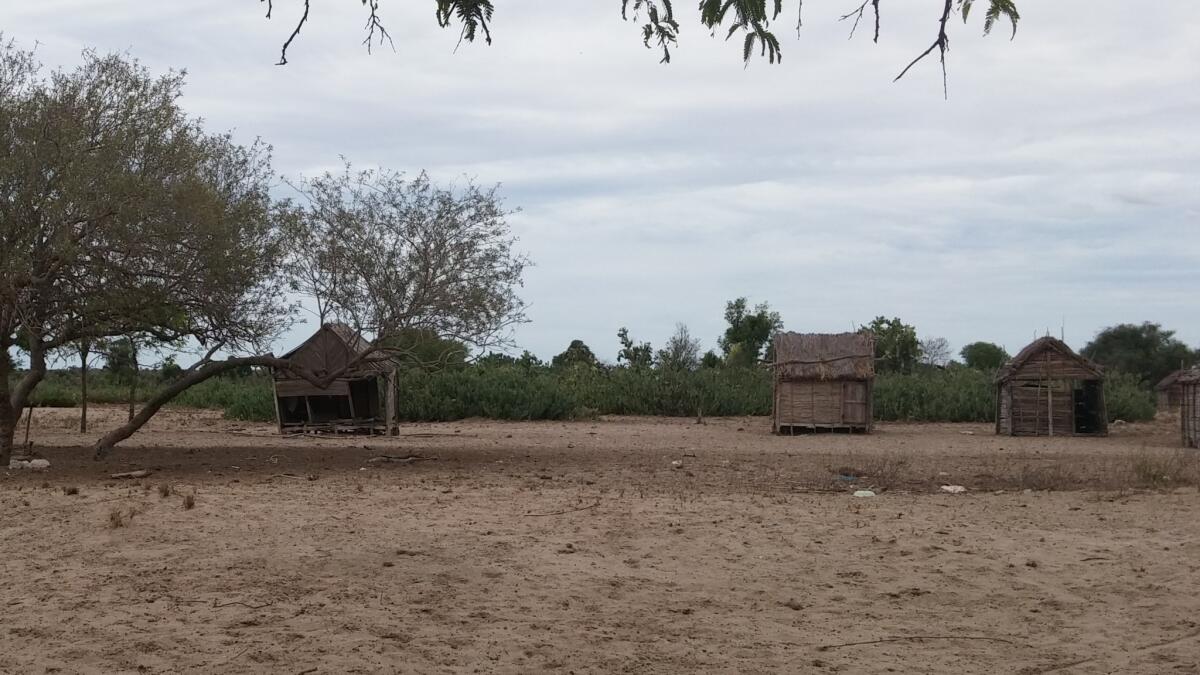In Madagascar, mothers weep and send their children to bed without water to drink

Reporting from KOBOKARA, Madagascar — Tiny wooden houses are scattered across the harsh gray sand of Kobokara hamlet in southern Madagascar. A woman squats in one of them, looking out her low door. Her small stick house is bare, but for a blanket, a mosquito net and a homemade straw mat.
Her words settle in a sigh: “I have nothing left.”
It is the lament of a parched land, where women cry for thirsty children, and farmers’ hope is spent.
In Madagascar, the island nation off the southeastern coast of Africa, a grim cycle has set in. Rains arrive late and leave early in the African country most exposed to climate change, according to the United Nations’ Food and Agriculture Organization. Droughts, earthquakes, epidemics, floods, cyclones and extreme temperatures have wrought severe damage on agriculture in recent decades.
The worst drought in 35 years pushed families to the brink in the last year, with the harvest 95% lower than in 2015.
Fringes of prickly pear cactus run through Kobokara, yet to bear fruit. Usually it is only cattle fodder.
“It’s been one year that we have been eating the leaves of the cactus,” said the woman in the stick house, Tonelie. Like many here, she has only one name.
Nearly 850,000 people in Madagascar desperately need food aid. But the U.N.’s humanitarian appeal for the country is only 29% funded because of emergencies elsewhere. Even the most desperate families are given only half of what they need to survive.
Each year, farmers in southern Madagascar sow their seeds in November for the rainy season, but in recent years the skies have only spluttered sulkily for a few weeks, before drying up and searing the immature crops.
Some rain finally arrived late last year, but many families had no seeds left to plant and no money to buy them.
I had no money to buy water, so my children were crying. Sometimes when I see my children crying, there’s a tear in my eye too.
— Jocelyn Rasoanakambana, 29, a single mother of six children in Ikopoky village, southern Madagascar
With repeated crop failures, people have to sell firewood to survive, taking small sharp axes and hacking efficiently at the trees that are the lungs of their dying country — only deepening the crisis.
Tonelie, 42, has six of her eight children still living at home and no husband. She has land to farm, but it is bare.
Eight months ago, she made the long, regretful walk to market to sell her last cow. Many people in this harsh land have sold their last goat or even their last chicken.
Then week by week, they have sold everything else: clothes, spoons, tin plates, cups, pots, plastic sheets. Even their mattresses.
They cling finally to their plastic water cans, receptacles of the last drops of hope.
Tonelie even had to sell hers.

Painfully thin, she speaks with quiet resignation. She rises each morning with empty pockets and has the hours of daylight to somehow come up with something so that she and her children can live another day. She works someone else’s land to earn the equivalent of about 30 cents a day.
She took her children out of school because there was no money, so they must help in the grinding job of survival.
In Kobokara, people dig holes in the sandy ground for water, but five months ago, the water dried up. Once a week, water sellers from a village to the east drive their ox carts nine miles along the deep sandy track, and Tonelie takes out the crumpled, sweaty banknotes that will decide her week.
“If I have [enough] money I buy two cans. If not I buy only one can,” said Tonelie, referring to the plastic five-gallon cans used to store water. (She has to borrow them.) In a bad week, that leaves the equivalent of just over one soda can apiece a day.
“My biggest problem is food,” she said. The 30 cents she earns as a farm laborer buys water, “but it’s not enough to buy food.” Her family survives on prickly pear cactus and occasional handouts from an uncle in a nearby village.
Across the south, small children endure constant, pitiless thirst. Mothers go without so that their children can drink a little more.
“The biggest issue in the south is water. They don’t have rain. They don’t have access to water, even in good years,” said Elke Wisch, UNICEF’s country director for Madagascar.
In the neighboring village of Ikopoky, Jocelyn Rasoanakambana, 29, puts her six children to sleep without water on the days she has no money.
“I can borrow a bit of money to buy water,” she said recently. “But when it’s day after day after day, even my relatives don’t want to give. When we have no money, we go to bed without drinking any water.
“Last Thursday was one of the worst days. I had no money to buy water, so my children were crying. I felt so helpless, thinking about what is happening to us. Sometimes when I see my children crying, there’s a tear in my eye too.”
In her village, three children in one family died recently and the parents moved away.
Humanitarian agencies such as the World Food Program, UNICEF, Catholic Relief Services and USAID have tried to help, providing cash grants, food, seeds, water and health projects. But their efforts haven’t been enough.
World Food Program rations had to be cut in half because the agency’s fundraising target from donors fell short, and some villages were never reached by humanitarian agencies.

“Families are ashamed abut not being able to provide for their kids. They’re embarrassed,” said Joshua Poole of Catholic Relief Services. “If a child passes away they wait until night to bury them, when no one else is around.”
From Tonelie’s house in Kobokara, it’s short walk past a rare shady tree to the small house of an old farmer named Veza. He plucks a red flower from the prickly pear cactus and bites into it with crooked yellow teeth. He planted last year, but the crop died; this year he had no money and no seeds, and there was not enough rain.
He senses his life is coming to an end, gradually whittled back to nothing.
Veza’s modest wealth was the work of a lifetime: three goats and four cattle, in a culture where money and pride are counted in herds of cows and bulls. But one of the cattle died. Four years ago, after bad rains and a failed harvest, he took the bitter decision to sell the other three.
“I didn’t have any choice. I felt terrible, because I didn’t have cattle. I had nothing.” A year later his wife, calling him weak, walked out and never came back.
Then two of his three goats died. And with dwindling hope in recent months, he sold the last goat and all his plates and pots.
“I am so unhappy. I’m just waiting out the rest of my life, until I die.”

Underlying the crisis is entrenched, grinding poverty, corruption and bad governance.
“We are talking about a country with a large majority of the population being extremely poor,” said Wisch. “There is a small group of the population which is extremely rich.”
Around 90% of Madagascar’s 23 million people live on less than $2 a day and 80% survive on less than a dollar, according to UNICEF. As a result of chronic malnutrition, nearly half of the children suffer stunting, the fourth highest rate in the world.
“Where you have chronic poverty and there’s a shock, people fall straight into crisis because they don’t have any reserves. They don’t have any food,” said Jean-Luc Siblot of the World Food Program. “In Madagascar, three years of poor rains and crop failures have led to a catastrophic situation.”
The U.N.’s ambitious Sustainable Development Goals — which include urgent action on climate change and the elimination of all hunger and poverty by 2030 — are supposed to see the world humanitarian community move beyond crisis mode. The aims include boosting people’s resilience, improving education, strengthening agriculture and reversing land degradation and deforestation.
But long-term goals take a back seat in times of crisis — a withering drought caused by the 2015-16 El Niño, and humanitarian emergencies in Nigeria and South Sudan triggered by war.
“Let’s be clear. To overcome a poverty situation such as this one, a development program by a number of international organizations will not solve the problem. It is the government and good governance that will at some point change the situation or make the situation a little better,” said Siblot.
“There needs to be reforms at all levels,” said Wisch, of UNICEF. “There needs to be a focus on bringing down the levels of corruption.”
Many farmers, defeated by drought, have left to work in the wetter, less impoverished north of the country, as rickshaw cyclists or illegal miners in protected forests. They include Tonelie’s former partner, the father of her eight children, who sent her $3 last year. She doubts she will ever see him again.
When it finally rained in Berohambato village in December, Kazy Liarihee felt a stirring of hope. Her husband hurried out early in the morning to plant the few seeds of cassava, maize and sweet potato that they have left. Even if the rain does last, the family with nine children will endure months of hunger before the harvest.
“It’s very hot,” she said. “There was no rain last year and we had no crop. The wind blows all the time, and we eat only red cactus.”
Twitter: @RobynDixon_LAT
This story was reported with a grant from the United Nations Foundation.
ALSO
Kenya’s High Court rules against government plan to close the world’s biggest refugee camp
Syrian war memorial is dividing Dresden, itself a symbol of the ravages of war
More to Read
Sign up for Essential California
The most important California stories and recommendations in your inbox every morning.
You may occasionally receive promotional content from the Los Angeles Times.








